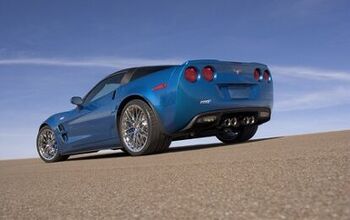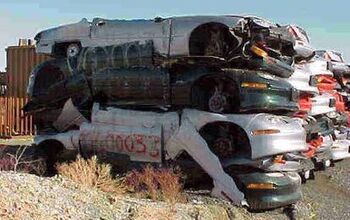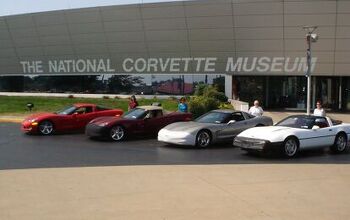Who Killed The Camry?

Blame the Rebels.
Nissan’s Rogue was the best-selling vehicle without a pickup bed in December of 2016, largely thanks to a massive advertising campaign that tied into one of the two recent Star Wars movies where only teenaged girls can be trusted to save the universe. Behind it, you had the usual suspects: CR-V, RAV4, Camry, Accord, Civic, Corolla. But even that state of affairs is a major change from business-as-usual a decade or two ago.
You can learn a lot about American society by looking at the best-selling car in any given year. So if we discount the Rogue’s Yavin IV-style moonshot performance, what’s changed about us since, say, 1967 — and what’s stayed the same? More importantly, who killed the Camry?
Once upon a time, the best-selling car in the America was the Ford Model T. This makes perfect sense, because the Model T was an utterly perfect device for putting a country on wheels for the first time. Simple, easy to operate, and hugely capable, the T was everybody’s first car well into the postwar period.
After that, the best-selling car in America was generally the full-sized “standard” Chevrolet. In 1965, it moved over a million units, making it nearly twice as popular as the overnight-sensation Mustang. It wasn’t until the Seventies that the Cutlass Supreme made a play for the top slot, mostly on the strength of the hugely popular coupe variant. The Chevy Citation and the Ford Escort were best-sellers after that.
By 1990, however, the holy trinity of Taurus, Accord, and Camry were in charge of affairs. The Camry eventually took the top spot and held it, on and off, for 20 years, easily fighting off a production-constrained Accord and a, um, demand-constrained Taurus. Wildly popular expansions to the lineup, like the hybrid model and the SE/XSE, should have ensured the Camry’s hegemony among actual passenger cars well into the supposedly inevitable electric-car transition phase.
Instead, the catfish-faced juggernaut finds itself scrapping with CUVs and subcompacts for a top-five slot. What’s going on? There are a few different theories that might apply.
Let’s call the first theory Lowered Expectations/Bigger Subcompacts. In this theory, Americans are short on money and optimism, so they’re making the move from the Camry to the Corolla. (The same holds true for the Accord, which is beaten in the sales charts by the Civic as often as it is not.) Surely this was why the Ford Escort took the top spot 35 years ago; a country drunk on long-hood expressions of personal-luxury power woke up the morning after the party and found a note from the President telling them to wear a sweater in the winter and choose a fuel-efficient car.
The relatively painless process of downsizing to the not-so-subcompact class has only been helping matters; a modern Corolla is really as big as an old Camry, and the new Civic is positively gargantuan. So this could be the winning theory, right off the bat.
The next explanation? How about Boomers Riding High. The Camry and Accord have long been mainstays of the Woodstock generation, but getting behind the wheel of one becomes much more difficult when you’ve got an artificial knee or a bad hip. Enter the CR-V and RAV4, which aren’t nearly as good at doing actual car things but offer the same kind of easy entry and exit the Boomers all remember from the Summer of Love. Certainly the sales leadership of what were once very niche vehicles (the RAV4 was originally marketed to ‘action sports’ types) offers support to this idea.
Last but maybe not least, we’ve got The American Snowflake. Deep inside, all of us know that we are very special people who deserve unique, curated experiences. Midsized sedans just don’t offer those curated experiences, do they? They’re the cars of our parents and our grandparents, people who were busy doing stupid, racist stuff like making America the leading economic power in the world and/or protecting it from the now-discredited Communist menace. We are too good to drive a Camry. The only way we can demonstrate our specialness is to drive something completely unique and amazing like a Prius or a RAV4, neither of which could ever be confused for regular, boring, transportation appliances like a Camry. Our active lifestyles demand ground clearance. Kaden’s soccer field has — you won’t believe it, Rechell! — unpaved parking.
Those are the theories. Which is correct? Maybe it’s all of them. But I yearn for a world where none of them would have any power whatsoever. I think about what Americans were expressing when they made the mighty V8-powered Cutlass Supreme (yes, I know not all of them were V8-powered) the nation’s leading car. I thrill to think of a country that would make a two-ton four-seater its favorite whip. We had style back then. But in a world where the automobile is increasingly seen as a problem to be solved, rather than an escape to freedom, who wants style? When our heroes are teenaged girls, why wouldn’t we be satisfied with a nice, safe, mommy’s-basement car like the RAV4?

More by Jack Baruth
Latest Car Reviews
Read moreLatest Product Reviews
Read moreRecent Comments
- Lou_BC "That’s expensive for a midsize pickup" All of the "offroad" midsize trucks fall in that 65k USD range. The ZR2 is probably the cheapest ( without Bison option).
- Lou_BC There are a few in my town. They come out on sunny days. I'd rather spend $29k on a square body Chevy
- Lou_BC I had a 2010 Ford F150 and 2010 Toyota Sienna. The F150 went through 3 sets of brakes and Sienna 2 sets. Similar mileage and 10 year span.4 sets tires on F150. Truck needed a set of rear shocks and front axle seals. The solenoid in the T-case was replaced under warranty. I replaced a "blend door motor" on heater. Sienna needed a water pump and heater blower both on warranty. One TSB then recall on spare tire cable. Has a limp mode due to an engine sensor failure. At 11 years old I had to replace clutch pack in rear diff F150. My ZR2 diesel at 55,000 km. Needs new tires. Duratrac's worn and chewed up. Needed front end alignment (1st time ever on any truck I've owned).Rear brakes worn out. Left pads were to metal. Chevy rear brakes don't like offroad. Weird "inside out" dents in a few spots rear fenders. Typically GM can't really build an offroad truck issue. They won't warranty. Has fender-well liners. Tore off one rear shock protector. Was cheaper to order from GM warehouse through parts supplier than through Chevy dealer. Lots of squeaks and rattles. Infotainment has crashed a few times. Seat heater modual was on recall. One of those post sale retrofit.Local dealer is horrific. If my son can't service or repair it, I'll drive 120 km to the next town. 1st and last Chevy. Love the drivetrain and suspension. Fit and finish mediocre. Dealer sucks.
- MaintenanceCosts You expect everything on Amazon and eBay to be fake, but it's a shame to see fake stuff on Summit Racing. Glad they pulled it.
- SCE to AUX 08 Rabbit (college car, 128k miles): Everything is expensive and difficult to repair. Bought it several years ago as a favor to a friend leaving the country. I outsourced the clutch ($1200), but I did all other work. Ignition switch, all calipers, pads, rotors, A/C compressor, blower fan, cooling fan, plugs and coils, belts and tensioners, 3 flat tires (nails), and on and on.19 Ioniq EV (66k miles): 12V battery, wipers, 1 set of tires, cabin air filter, new pads and rotors at 15k miles since the factory ones wore funny, 1 qt of reduction gear oil. Insurance is cheap. It costs me nearly nothing to drive it.22 Santa Fe (22k miles): Nothing yet, except oil changes. I dread having to buy tires.


































Comments
Join the conversation
This is a late comment but I'll weigh in by saying Australian fleet buyers are Camry's prison bitch. A casual observer will see that this wide, brown land won't let the sun set until everything you reverse into or trip over is a Camry Cop car.
I don't think the fad toward steeply raked A pillars and low roofs is a good thing. I drove a Matrix for 12 years and love the ease of entry/exit, and the practicality. I can't get in and out of an iM. The topic is Camry, but I think the principle applies.